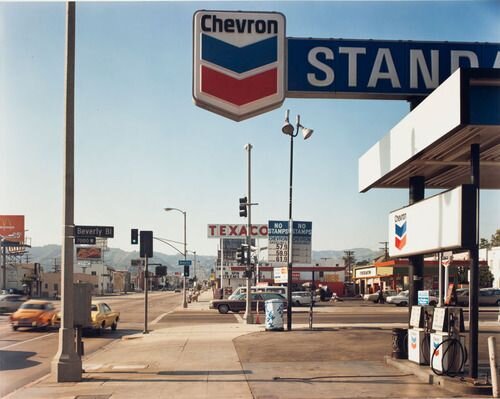WHAT IS NEW TOPOGRAPHICS?
New topographics was a term coined by William Jenkins in 1975 to describe a group of American photographers, whose pictures had a similar banal aesthetic, in that they were formal, mostly black and white prints of the urban landscape.
The new topographics was a reaction to the growing unease about how the natural landscape was being eroded by industrial development, it revealed that some of the people where getting uneasy about the environmental issues this could cause.
The new topographics were to have a decisive influence on later photographers including those artists who became known as the Düsseldorf School of Photography.
Unlike their predecessors, these new “topographic” photographers (such as Robert Adams, no relation to Ansel) were less concerned with portraying an ideal image of nature and were more interested in showing plainly how man has altered it.
NEW TOPOGRAPHIC MOODBOARD:

Post-war America struggled with:
Inflation and labour unrest. The country’s main economic concern in the immediate post-war years was inflation; the baby boom and suburbia. Making up for lost time, millions of returning veterans soon married and started families; isolation and splitting of the family unit, pharmaceuticals and mental health problems, and vast distances, road networks and mobility
IMAGE ANALYSIS:

This image was taken by Stephen Shore. This was a historical image about Americas oil revolution. Due to America being such a huge continent, therefore lots of people own cars, oil and gas station are not unusual thing to find on the side of the road. Chevron oil station in 2003 had a class action lawsuit a in Ecuadorian court for $28 billion by indigenous residents. This is because accusations of Texaco of making residents ill and damaging forests and rivers by discharging 18 billion US gallons (68,000,000 m3) of formation water into the Amazon rainforest. This image shows the evolution of man kind and how we have affected the environment by building and producing unnatural objects. I believe that Adams was trying to shows this by including the oil station in the photograph whereas in the background showing the mountains and showing the disruption we have had to the environment. The image is centred and the focal pint of the image would be the “TEXACO” and the “CHEVRON” signs this is due to the bright red colour of the sign. In this image it uses 3 primary colours of red, blue and white which symbolises the colours of the American Flag.
